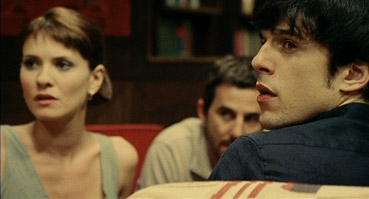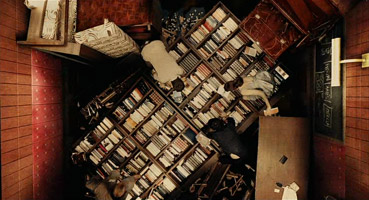|
Fermat's Room [La habitación de Fermat] is one of those rare little movies that only needed a brief plot summary to get me hooked. Try this for size.
Four eminent mathematicians each receive invites to a weekend in which they will be collectively asked to solve one of the great theoretical problems of the modern age. All are given nicknames based on famous mathematicians – (David) Hilbert, (Évariste) Galois, (Paulo) Oliva and (Blaise) Pascal – and all are requested leave their mobile phones at home so that the weekend will not be subject to outside disruption. Shortly after their arrival, their host is called away and they find themselves locked in a room and fed time-limited puzzles via a PDA. If the problems are not solved by the set deadline, the walls begin to move and shrink the size of the room until the correct answer is entered. As the puzzles continue and the threat to their lives increases, the four divide their time between solving their persecutor's riddles and trying to work out who is doing this to them and why.
It's a nifty setup with recognisable antecedents, the most obvious example being Vincenzo Natali's 1997 Cube, although the basic concept stretches back to Agatha Christie's 1939 And Then There Were None (aka Ten Little Indians and originally published under a title that would make you wince now) and probably beyond. The appeal for feature film first-timers with small budgets must be considerable, requiring only one main set, no costume changes, limited props and little in the way of special effects. But if the action is to built largely around dialogue, performances and plot twists then they'd better deliver, and for the most part Fermat's Room holds it's own on all three.

Characters are established economically and the puzzle-solving that will become crucial to their survival is introduced at an early stage, from the invite itself to the small teasers that lead the group to the isolated grain store in which their prison has been constructed. Lateral thinking is key to the problem-solving, and the puzzles themselves all have logical solutions that invite the audience to get there before the increasingly rattled group – a couple are even famous enough to have you shouting the answer at the screen in a vain hope that you'll be able to help. The twists are well timed and the misdirection largely effective, and first time feature directors Luis Piedrahita and Rodrigo Sopeña keep the pace and tension boiling and do well by room's sense of claustrophobic confinement, even if they intermittently let us off the hook to follow Fermat's actions outside (there is purpose to this, as it happens).
Unlike Cube, whose captives appear to have been selected solely for their individual skills, the victims here have been chosen with specific purpose, one that only becomes clear through the piecing together of clues that may or may not have been discovered by chance. It's in the reasons for bringing the group together that the film loses out to its predecessor, which sidestepped the possibility of explanation disappointment by simply not providing one. Here, the reason for the group's imprisonment and psychological torture is eventually revealed and it's just not the super-smart revelation the set-up demands. It's also one that, some have suggested, throws up almost as many questions as it answers, questions the film's supporters have provided some inventive and plausible responses to.
But this is still a thoroughly engrossing thriller that adapts Cube's central premise and then confidently runs in its own inventive direction with it. That the resolution does match the ingenuity of the build-up is disappointing but perhaps a little unsurprising, being another in a string of recent genre works in which writers appear to have spent so much creative energy on the set-up that they have had little left for the resolution. In spite of this, Fermat's Room is still a smartly devised and developed take on a still effective tension-building formula, and very promising first feature for Piedrahita and Sopeña.
A difficult call. The picture is anamorphic 1.85:1, but has been subjected to quite a bit of post-production tinkering, which has upped the contrast, heavily tinted the picture and added a degree of what appears to be artificial digital grain, which is nowhere near as prominent on the (untreated) deleted scenes footage. This does seem to be all intentional, and within these filmmaker imposed restrictions the transfer is a solid one, with a reasonable level of detail and consistency to the contrast and colour.

You can choose between Dolby stereo 2.0 and Dolby 5.1 surround, and, perhaps surprisingly, I preferred the stereo track, which has a wider frontal spread and a little more punch. The 5.1 is more subtle, but makes little use of specific areas of the sound stage.
The subtitles are small but clear, less obtrusive than the norm but better suited to larger screens. They are also fixed rather than optional, a little surprising for a recent DVD release.
Making of (10:49)
A fast-cut EPK in which cast and crew extol the virtues of the script, the film, the characters, and each other. The directors do provide some info on their thinking behind the project, and there is some behind the scenes footage, but revelatory this is not.
Deleted and Extended Scenes (18:12)
Directors Rodrigo Sopeña and Luis Piedrahita introduce a collection of deleted and extended scenes and explain the reasons for their removal. All are interesting I their own right, particularly the subtle references to Hitchcock and to Harvey Keitel's character in Smoke, while the multilingual solution to the first numerical problem did make me wonder we why didn't get the English version that was shot and edited especially for us.
3D Plans (0:59)
A brief but still revealing glimpse at how two of the key effects shots in the film took shape.
Out Takes (3:51)
A small collection of outtakes, none as amusing as you might hope.
Rehearsals (6:52)
Rehearsals for 3 scenes, two of which are shot and cut in what looks like a directorial dry run for the film itself.
Be honest, how many thrillers can you name in which the central characters are mathematicians whose lives depend on their ability to solve logic problems? The format of trapping a group of strangers in a room and setting them puzzles with potentially lethal outcomes may have an imposing godfather in Cube and has been since intriguingly (if not totally successfully) reworked in Frédéric Grousset's 2004 Aquarium, but directors Piedrahita and Sopeña still do well by the concept and have produced a work that deserves to be judged on its own considerable merits. A decent enough DVD from Revolver, with an OK selection of extras. Definitely worth checking out.
|